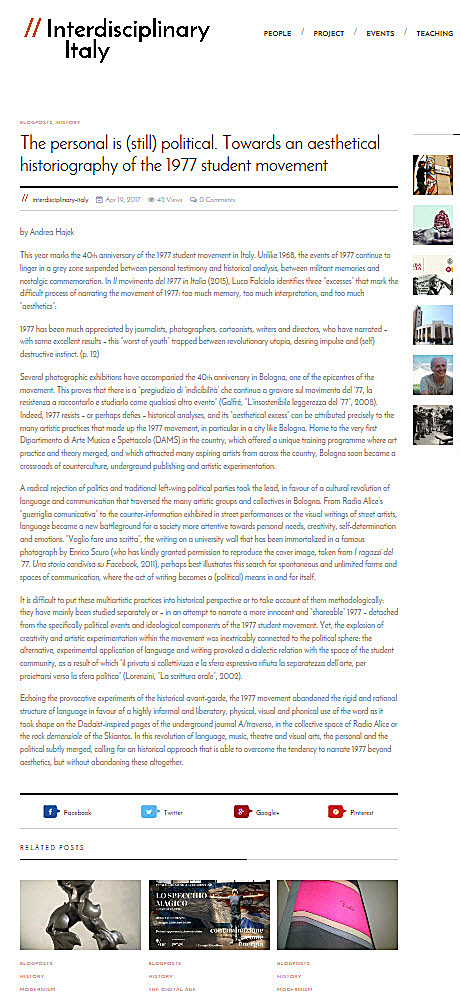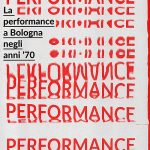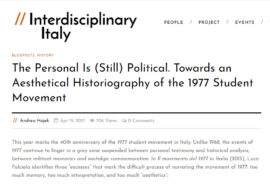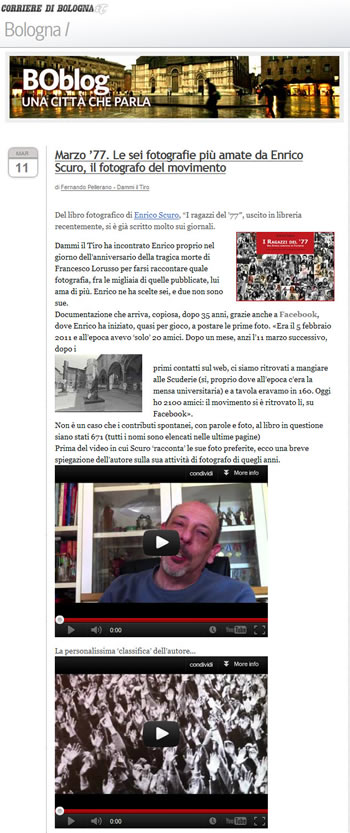 The personal is (still) political. Towards an aesthetical historiography of the 1977 student movement
The personal is (still) political. Towards an aesthetical historiography of the 1977 student movement
by Andrea Hajek
Interdisciplinary Italy
This year marks the 40th anniversary of the 1977 student movement in Italy. Unlike 1968, the events of 1977 continue to linger in a grey zone suspended between personal testimony and historical analysis, between militant memories and nostalgic commemoration. In Il movimento del 1977 in Italia (2015), Luca Falciola identifies three “excesses” that mark the difficult process of narrating the movement of 1977: too much memory, too much interpretation, and too much “aesthetics”:
1977 has been much appreciated by journalists, photographers, cartoonists, writers and directors, who have narrated – with some excellent results – this “worst of youth” trapped between revolutionary utopia, desiring impulse and (self)destructive instinct. (p. 12)
Several photographic exhibitions have accompanied the 40th anniversary in Bologna, one of the epicentres of the movement. This proves that there is a “pregiudizio di ‘indicibilità’ che continua a gravare sul movimento del ’77, la resistenza a raccontarlo e studiarlo come qualsiasi altro evento” (Galfré, “L’insostenibile leggerezza del ’77”, 2008). Indeed, 1977 resists – or perhaps defies – historical analyses, and its “aesthetical excess” can be attributed precisely to the many artistic practices that made up the 1977 movement, in particular in a city like Bologna. Home to the very first Dipartimento di Arte Musica e Spettacolo (DAMS) in the country, which offered a unique training programme where art practice and theory merged, and which attracted many aspiring artists from across the country, Bologna soon became a crossroads of counterculture, underground publishing and artistic experimentation.
A radical rejection of politics and traditional left-wing political parties took the lead, in favour of a cultural revolution of language and communication that traversed the many artistic groups and collectives in Bologna. From Radio Alice’s “guerriglia comunicativa” to the counter-information exhibited in street performances or the visual writings of street artists, language became a new battleground for a society more attentive towards personal needs, creativity, self-determination and emotions. “Voglio fare una scritta”, the writing on a university wall that has been immortalized in a famous photograph by Enrico Scuro (who has kindly granted permission to reproduce the cover image, taken from I ragazzi del ’77. Una storia condivisa su Facebook, 2011), perhaps best illustrates this search for spontaneous and unlimited forms and spaces of communication, where the act of writing becomes a (political) means in and for itself.
It is difficult to put these multiartistic practices into historical perspective or to take account of them methodologically: they have mainly been studied separately or – in an attempt to narrate a more innocent and “shareable” 1977 – detached from the specifically political events and ideological components of the 1977 student movement. Yet, the explosion of creativity and artistic experimentation within the movement was inextricably connected to the political sphere: the alternative, experimental application of language and writing provoked a dialectic relation with the space of the student community, as a result of which “il privato si collettivizza e la sfera espressiva rifiuta la separatezza dell’arte, per proiettarsi verso la sfera politica” (Lorenzini, “La scrittura orale”, 2002).
Echoing the provocative experiments of the historical avant-garde, the 1977 movement abandoned the rigid and rational structure of language in favour of a highly informal and liberatory, physical, visual and phonical use of the word as it took shape on the Dadaist-inspired pages of the underground journal A/traverso, in the collective space of Radio Alice or the rock demenziale of the Skiantos. In this revolution of language, music, theatre and visual arts, the personal and the political subtly merged, calling for an historical approach that is able to overcome the tendency to narrate 1977 beyond aesthetics, but without abandoning these altogether.














 Andrea Hajek
Andrea Hajek






























